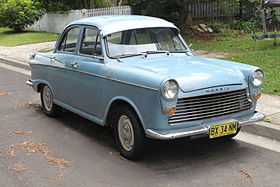Morris Major
| Morris Major | |
|---|---|

Morris Major Elite
|
|
| Overview | |
| Manufacturer | BMC Australia |
| Also called | Austin Lancer |
| Production | 1958-1964 |
| Assembly | Victoria Park, Australia |
| Body and chassis | |
| Class | Sub-compact |
| Body style | 4-door sedan |
| Layout | FR layout |
| Related | Wolseley 1500/Riley One-Point-Five |
| Powertrain | |
| Engine | BMC B-Series engine, 1489 & 1622 cc |
| Transmission | 4-speed manual, synchromesh on 2,3 & 4 |
| Dimensions | |
| Wheelbase | 92 in (2,300 mm) |
| Length | 161 in (4,100 mm) |
| Width | 61 in (1,500 mm) |
| Curb weight | up to 940 kg (2,072 lb) |
| Chronology | |
| Successor | Morris 1100 |
The Morris Major and Austin Lancer are passenger car models that were produced by BMC Australia between 1958 and 1964. The Morris Major name had been used before, by Morris Motors in Britain, for a six-cylinder car produced from 1931 to 1933.
The Morris Major and Austin Lancer were introduced in 1958, designated DO1101 and developed from the contemporary Wolseley 1500 and Riley One-Point-Five models then on sale in the United Kingdom. The Major and Lancer, along with the Wolseley 1500 were produced at BMC Australia's Victoria Park plant at Zetland in Sydney, Australia and were unique to that country, having around 98% local content. Australian produced Wolseley 1500s were also given the DO1101 model code.
The Morris Major/Austin Lancer/Wolseley 1500/Riley One-Point-Five all shared the same core design which had originally been developed as a possible replacement for the ever-popular Morris Minor by BMC's in-house design team at Longbridge, England. That plan was abandoned due to the Minor's unwavering appeal with the buying public and a Wolseley version was instead unveiled in 1957, followed by the Riley. They were light, close-coupled saloons incorporating the front torsion bar/rear leaf spring suspension, floorpan and superb rack and pinion steering from the Morris Minor. These automotive "quadruplets" were powered by the famous B series power unit (I4,) of 1489 cc. All were equipped with large, heavy duty drum brakes - by Lockheed for the Wolseley, Morris and Austin and Girling for the Riley. This formula resulted in a popular small-to-medium family car with lively performance, robust build and road manners that were quite above average for the time. The Major and Lancer, as distinct from the sportier and more luxurious Wolseley/Riley cars, shared a similar level of appointment, finish and engine tune with contemporary Morris and Austin models. Although comparatively modest, the Major/Lancer had a generally high level of comfort and quality: it was a modern car offering sound value. The sporting potential of the Major/Lancer was recognised almost immediately and specialist-modified cars were raced into the early 1960s.
...
Wikipedia
